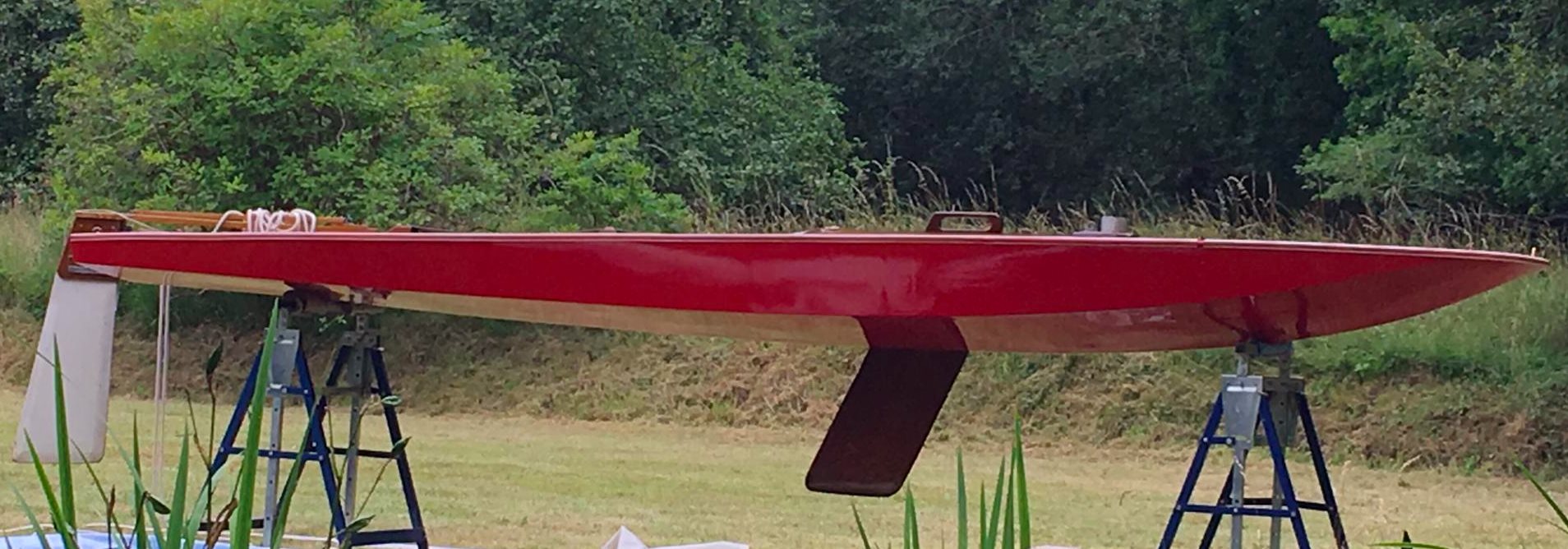The gorgeous Meson..... a MiniSprint Mk2 hull (although at least one is known to be all plywood) with an open cockpit, decked in timber.
They usually have a sliding seat, though the 1976 Boat Show model was shown with wings. Its not known who made the professionally-decked ones (possibly Vandercraft) and its not clear (to me anyway) whether a home-completed composite MiniSprint Mk2 (of which there were a few) is really any different. Richmond Marine made Sprint Mk2 open hulls for home completion (see Stuart's recollections below).
The moulds for the deck of the MiniSprint Mk2 are believed to be lost, however the hull mould (or possibly a plug) is still in existence and in reasonable condition - anyone with the requisite skill and experience fancy making a new GRP or FRP composite then just get in touch (see contact details at the bottom of the page).
Stuart Preston recalls his Sprint mk2 “Geordie”:
”Hello Minisail members, I have just been looking at the 1976 Minisail Yearbook and found an article I wrote all those years ago about Rigging and Deck layout. My last Minisail was the new sprint MK2 named Geordie. I purchased and collected the fibreglass hull from Richmond Marine. I then built a wooden deck onto the glass hull. The deck design I used closely followed the full glass fibre version. I believe my version was lighter than the all glass version which gave me a slight edge in racing. The centre board was shaped like an aeroplane wing with the maximum thickness 1/3 back from the leading edge. Having an open transom, I also made my own rudder and stock with a split, cranked and laminated tiller. This enabled the tiller to fit around the middle of the stock instead of the top, much stronger. I did have rudder problems with earlier Minisails so this new design of mine solved the old problems. The rudder too was profiled again as per the centre board but where the blade entered the water the blade was quite narrow to reduce surface drag. I also made the rudder go straight down into water and not angled back as most Minisails have. All these modifications made the boat very well balanced without the heavy helm experienced in strong winds. Geordie was a very quick boat it had the ability to pass other boats to leeward by close reaching past, then luffing up after passing. I used this tactic every time another competitor tried to luff me on the windward leg. I often received the comment 'how did you do that'. I did read sailing mags back then and remember this method of passing other boats to leeward being used. Remember an opponent can luff you but he cannot bear down on you under the rules. Hope you all find this article interesting. Have fun with your Minisails I certainly did.”
...And Tom Moore recalls some details of his home-completed Meson:
" I followed these principles with my fibreglass shell. I had to make a slender inwhale to sit on top of the hosepipe shape stiffener in grp. The ( 18 mm square ? ) inwhale came about flush with the deck to bond the decks onto with epoxy.
The crescent shaped bulkheads in my plans ( a la dish decked Monaco Mk1 ), I modified to my deck plan: side tanks and open transom to give more buoyancy at the back end and easier seat fitting. I used a bicycle wheel rim to ‘steam’ the inwhale round the bow section, but laminating would be possible on a former with pegs, as used for the seat sides to give a gentle curve. Woven roving tape and or fillets of epoxy to hold everything in place. It was all done over 2 weeks or so at Christmas in the utility room of the hospital flats when other tenants were away.
I originally made a footwell but didn’t want a bailer or water trapped there, so added a higher false floor either side of the centreboard slot, at its top height. ( My shell had a centreboard length slot, but if redecking a Monaco or Mk 1 Sprint that would not be the case ). The ply was all 4mm, gaboon faced and epoxy coated both sides, with a very few small brass screws, eg to hold the transom lamination into the inwhale. I had difficulty attempting the impossible, bending the one piece foredeck ply into two curves, but it was nearly fair. I should have had a split in the middle. The light triangular mouldings for the
gunwhale were Ramin-the only off the peg ones I could find. They came up level with the deck edges. Originally I think the weight was about 50kg, but now it’s nearer 60 30 years later, no doubt the foam has taken up water, and perhaps some of the wood too. Rain filled the tank at one point, in spite of the cover. The foam was meant to allow drainage through the 4 bung holes at the stern, but that was not totally successful-it did expand so much. Oh well, build it again I hope soon!
Tom "

